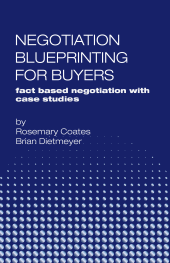 There are essentially only two kinds of impasses in business negotiations. The first, the emotional impasse, occurs when a deal is on the table that's better than both sides' Consequences of No Agreement (CNA), but they still don't come to an agreement. Situations like this are usually the result of one or both sides misdiagnosing their CNA. The best way to deal with this is to go back and evaluate the CNAs again, validate them again, diplomatically educate the other side about them, and re-present the offer.
There are essentially only two kinds of impasses in business negotiations. The first, the emotional impasse, occurs when a deal is on the table that's better than both sides' Consequences of No Agreement (CNA), but they still don't come to an agreement. Situations like this are usually the result of one or both sides misdiagnosing their CNA. The best way to deal with this is to go back and evaluate the CNAs again, validate them again, diplomatically educate the other side about them, and re-present the offer.
A second kind of impasse is the structural impasse, which occurs when the deal on the table isn't as good as the CNA of one or both sides, and as a result they can't come to agreement. Let's say, for example, that a deal is on the table, but the two sides are $2000 apart based on their CNAs -- the buyer can get it cheaper (for $4000), and the seller can get a higher price ($6000). There are two options in this situation. The first is to simply walk away from the deal, and sometimes that makes sense; after all, not all deals should happen. In fact, many times walking away from a deal below market yield makes more money for you in the long run, because you don't reset your price in the market. (A steel manufacturer client of ours says that 5 tons of discounted steel can result in 500 tons of discounted steel!) If, however, it's a deal that should happen, the best way to correct this kind of structural impasse is to attempt to find other items to trade into the deal to create an additional $2000 of value that can be used to close the gap. This might include something like incremental business in another division or the customer's picking up a new product line.
Sometimes, no matter what kind of trade you suggest during this stage of negotiation, you still feel as though you're running into a brick wall. Your customer is insisting on something that you just can't give in on, and there doesn't seem to be any way out. An excellent way, however, that lets you avoid impasse in a situation like this does exist. That way is for you to ask a series of questions designed to help you understand why your customer is being so insistent: "Help me understand why that's important." "How does that have an impact on your personal success?" "How does it have an impact on your department's success?" "Why is that so high on your priority list?" In asking such questions, you will in all likelihood discover a substantial difference between what your customer is asking for and why he or she is asking for it.
Let's look at length of contract as an example. Normally, you would want a contract to run as long as possible in order to lower your company's risk and ensure longer-term cash flow. Your customer, on the other hand, will probably want to keep the length as short as possible to have the flexibility of taking advantage of new and emerging suppliers. In a situation like this, you can argue two versus three years until you're both blue in the face. But it's only by understanding the underlying interests involved that you'll be able to find a way to address them and reach agreement. In fact, once you've found out why someone wants something, you can usually find several different ways to fill that need. For example, in situations like this one I've often seen deals that include a right-of-first-refusal clause that speaks to the underlying interests of those on both sides of the table. In fact, identifying underlying interests is one of the key aspects of trading in negotiation and a very useful skill.





